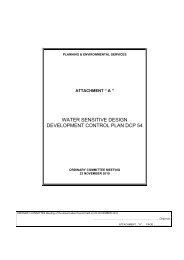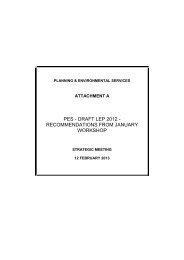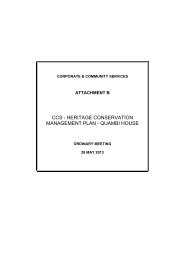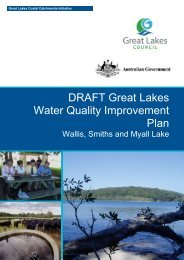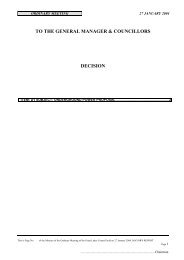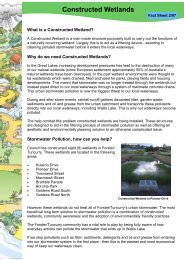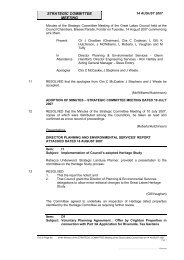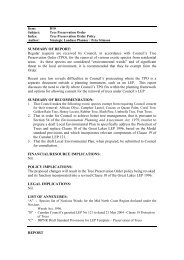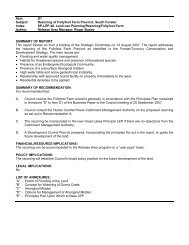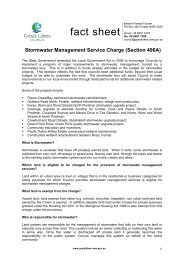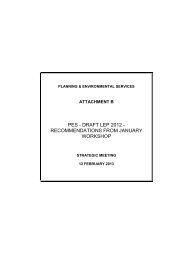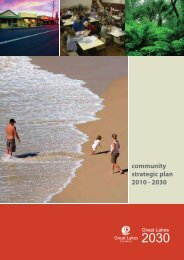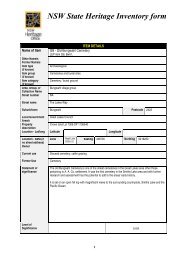13.2 The Wallis Lake Estuary Management Committee - Great Lakes ...
13.2 The Wallis Lake Estuary Management Committee - Great Lakes ...
13.2 The Wallis Lake Estuary Management Committee - Great Lakes ...
You also want an ePaper? Increase the reach of your titles
YUMPU automatically turns print PDFs into web optimized ePapers that Google loves.
<strong>Wallis</strong> <strong>Lake</strong> <strong>Estuary</strong> <strong>Management</strong> Plan<br />
Table 6.1: WLEMP monitoring overview<br />
Strategy/Outcome Actions Monitoring and performance indicator Data interpretation Target Comments Progress<br />
Minimise stormwater<br />
pollutants entering the lake<br />
W.1.1,<br />
W.1.2,<br />
W.1.4,<br />
W.1.5,<br />
W.1.6<br />
A monitoring program to assess the<br />
effectiveness of SQIDs would involve<br />
‘upstream’ and ‘downstream’ sampling of<br />
drainage lines. Indicators to be measured<br />
include; total nitrogen (TN), total phosphorus<br />
(TP), oxidised nitrogen (NOx), ammonia (NH4),<br />
filterable reactive phosphate (PO4), dissolved<br />
oxygen and turbidity.<br />
Replicate samples should be collected during<br />
wet weather events when stormwater is<br />
flowing. A thresh hold should be decided upon<br />
to ensure consistency of the magnitude of the<br />
wet weather events ie. 50 mm rain in 24 hours.<br />
Samples to be processed at Forster<br />
Environmental Laboratory.<br />
An example of a monitoring design to assess<br />
the effectiveness of artificial wetlands on the K-<br />
leg drainage line is given in Fig. 6.1.<br />
Each wetland is a replicate<br />
unit for water filtration and<br />
treatment (n=4).<br />
Conventional t-tests or<br />
single factor ANOVA could<br />
be used to compare<br />
upstream and downstream<br />
data from one off sampling,<br />
or two factor ANOVA could<br />
be used to compare<br />
upstream and downstream<br />
data from multiple sampling<br />
events.<br />
N/A This monitoring<br />
program would<br />
allow the cost<br />
effectiveness of<br />
artificial wetlands to<br />
be assessed and<br />
would contribute to<br />
the management<br />
decision-making<br />
framework<br />
regarding future<br />
construction of<br />
such SQIDs.<br />
Waterwatch sampling is currently active at<br />
Forster Keys, Tuncurry Boat Ramp, Darawakh<br />
Memorial Park and the Nabiac Weir,<br />
Pennington Creek and Dunnes Creek.<br />
Sampling is conducted by trained community<br />
volunteer groups and coordinated by DIPNR.<br />
Indicators measured include; temperature, pH,<br />
total dissolved solids, turbidity and dissolved<br />
oxygen.<br />
Once data is uploaded to<br />
the Waterwatch website,<br />
graphs are automatically<br />
created and displayed<br />
allowing a visual<br />
interpretation of trends at<br />
each site.<br />
N/A<br />
Data available at<br />
www.waterwatch.ns<br />
w.gov.au<br />
99




